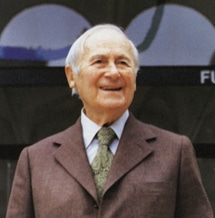Behind the Artist: Joan Miró
Joan Miró defied the art world with groundbreaking artwork that pushed the boundaries of abstraction into its current form and paved the way for modern art. Intrigued by the artists gathering in [...]

1893–1983
Spanish artist Joan Miró is viewed by the art world as one of the most important artists of the 20th century and a precursor of modern art.
Miró was a prolific artist who worked in painting, printmaking, sculpture, tapestry, and ceramics. His art, known for invoking a childlike sense of expression, can be found in distinguished museums around the world.
READ MORE +Miró was born in Barcelona, Spain, as the son of a goldsmith and jewelry maker. He displayed a talent for art at a young age, creating his first successful drawing at 8 years old. In 1907, he studied at a business school in Barcelona and at the Barcelona School of Fine Arts, where he was admitted at the early age of 14.
After three years of schooling, his parents dissuaded him from becoming an artist, so he began to work as an accountant. However, Miró’s work didn’t satisfy him, resulting in a nervous breakdown. His parents moved him to an estate they purchased in Mont-roig del Camp to help him recover. Miró abandoned the business world and studied at the Francesc Galí’s Escola d’Art in Barcelona from 1912 to 1915.
In 1916, the young artist frequented the Dalmau gallery in Barcelona, and came to know the owner, José Dalmau. Dalmau, also an art dealer, hosted Miró’s first-ever solo exhibition in 1918. Unfortunately, the show was met with harsh critiques and Miró didn’t sell a single painting. The artist sought inspiration elsewhere, and in 1920 made his first trip to Paris.
Miró met Pablo Picasso and other important emerging artists in Paris, which served as the cultural center for art in the early part of the 20th century. In 1921, Dalmau gave Miró another chance and hosted Miró’s first exhibition in Paris at the Galerie la Licorne. He soon after gained critical and popular success for his work and continued to exhibit in local galleries.
By 1924, Miró had aligned himself with the Surrealist movement through founder and proponent, Andre Breton. He associated with the artists Max Ernst, Andre Masson, and others, but always remained on the periphery of Surrealism. In 1925, his solo exhibition at the Galerie Pierre was considered a major Surrealist event. This led to his inclusion in the first-ever Surrealist exhibition held that same year.
In 1928, Miró took a trip to the Netherlands to study the works of Dutch realist painters. A year later, Miró began working in lithography. During this time, Miró’s works became more experimental, declaring an “assassination of painting” in the hopes of upsetting the established bourgeois art with a new visual vocabulary.
Miró’s fame and recognition catapulted during the 1930s when his artwork was introduced to the United States. At this time, Miró experimented with other mediums, including collage, sculpture, and costume and set design for ballets.
The Spanish Civil War led Miró to explore new themes in 1934, creating his “Savage Paintings.” From 1936 to 1939, he was exiled from Spain and returned to Paris. He eventually fled Paris in 1941 during World War II to return to Spain and then the United States. That same year, his first major retrospective was held at the Museum of Modern Art in New York.
The artist created ceramics with Josep Lloréns y Artigas in 1944, creating purposefully misshapen and fragmented works. In the years following World War II, Miró’s art was exhibited throughout the world, and in 1948, he began dividing his time between Spain and Paris. In 1956, Miró settled in Majorca, Spain, in a studio that eventually became the Miró Museum after his death.
Miró continued to enjoy international fame and success, including retrospectives in New York, London, Saint-Paul-de-Vence, and Paris in the early ‘70s.
Miró’s impressive career includes the creation of 2,000 paintings, 500 sculptures, 400 ceramic objects, 5,000 drawings, more than 1,000 different lithographic editions and multiple etchings. He also created illustrations for more than 250 books.
He became one of the most prolific creators of original lithographs and etchings, using highly-textured applications of color—a technique that would later be called carborundum aquatint.
Miró died on December 25, 1983, at his home in Palma, Spain.
Those who knew Miró described him as a remarkably modest man who wore dark business suits. He was considered orderly, detail oriented, meticulous, and reliable. Defying the stereotype of the modern artist, there was nothing “bohemian” present in him.
Miró is most well known for his use of organic forms, flattened planes, playful shapes, and bright colors that draw upon recreating childlike wonderment and pure expression.
Initially, Miró was inspired by folk art and church frescoes of his native Catalan region as well as prehistoric art. He even found inspiration from Dutch realists during a trip to the Netherlands.
After moving to Paris, the artist became inspired by more contemporary sources: Surrealism, Dadaism, Fauvism, and Cubism. These styles were becoming popular while Miró resided in Paris, and no doubt played a role in shaping his style.
By 1930, Miró had developed his own unique style of imagery. Eventually, Andre Breton, the founder of the Surrealist movement, described him as, “the most surreal of us all.” He was among the first artists to use automatism, a technique often associated with the Surrealists. Automatism is a method that suppresses the conscious mind so the subconscious, chance, and randomness can guide the artist’s hand.
Miró drew upon both microcosms and macrocosms in his art. His artwork simultaneously invokes particles, cellular life, and celestial bodies. This not only opens his artwork up to interpretation, but causes the viewer to ponder their inner-selves as well as the cosmos they inhabit.
for breaking news, artist updates, and special sale offers